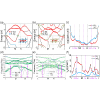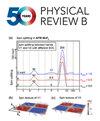Unveiling the microscopic dynamics of the charge density wave transition in monolayer VX2 (X=S, Te)
IF 3.7
2区 物理与天体物理
Q1 Physics and Astronomy
引用次数: 0
Abstract
Charge density waves (CDWs) in two-dimensional materials have received great attention due to their intriguing properties, yet the microscopic evolution process of CDW transition and its impact on charge transport remain to be fully understood. Herein we employed density-functional theory calculations to ascertain the richness of CDW phases in (, Te) originated from electron-phonon coupling. Reversible transitions between the normal and CDW phases are directly simulated with ab initio molecular dynamics, indicating that the formation of CDW phase is a rapid nucleation process. The corresponding microscopic dynamic processes involve the formation, flipping, translation, and aggregation of characteristic patterns, which are driven by the soft phonon modes. Modifications of electrical conductivity in CDW phase transition are found to stem from the varying orientation and location distributions of relevant wave functions. The revealed dynamic mechanism opens an opportunity for the control of CDW phase transition that is crucial to its applications in logical circuits and neural networks.

揭示单层 VX2(X=S,Te)中电荷密度波转变的微观动力学特征
二维材料中的电荷密度波(CDWs)因其引人入胜的性质而备受关注,然而 CDW 转变的微观演化过程及其对电荷传输的影响仍有待充分了解。在此,我们采用密度泛函理论计算来确定 VX2(X=S,Te)中源于电子-声子耦合的 CDW 相的丰富性。利用原子分子动力学直接模拟了正常相和 CDW 相之间的可逆转变,表明 CDW 相的形成是一个快速成核过程。相应的微观动态过程涉及特征图案的形成、翻转、平移和聚集,这些过程由软声子模式驱动。研究发现,CDW 相转变过程中导电性的改变源于相关波函数取向和位置分布的变化。所揭示的动态机制为控制 CDW 相变提供了机会,这对其在逻辑电路和神经网络中的应用至关重要。
本文章由计算机程序翻译,如有差异,请以英文原文为准。
求助全文
约1分钟内获得全文
求助全文
来源期刊

Physical Review B
物理-物理:凝聚态物理
CiteScore
6.70
自引率
32.40%
发文量
0
审稿时长
3.0 months
期刊介绍:
Physical Review B (PRB) is the world’s largest dedicated physics journal, publishing approximately 100 new, high-quality papers each week. The most highly cited journal in condensed matter physics, PRB provides outstanding depth and breadth of coverage, combined with unrivaled context and background for ongoing research by scientists worldwide.
PRB covers the full range of condensed matter, materials physics, and related subfields, including:
-Structure and phase transitions
-Ferroelectrics and multiferroics
-Disordered systems and alloys
-Magnetism
-Superconductivity
-Electronic structure, photonics, and metamaterials
-Semiconductors and mesoscopic systems
-Surfaces, nanoscience, and two-dimensional materials
-Topological states of matter
 求助内容:
求助内容: 应助结果提醒方式:
应助结果提醒方式:


